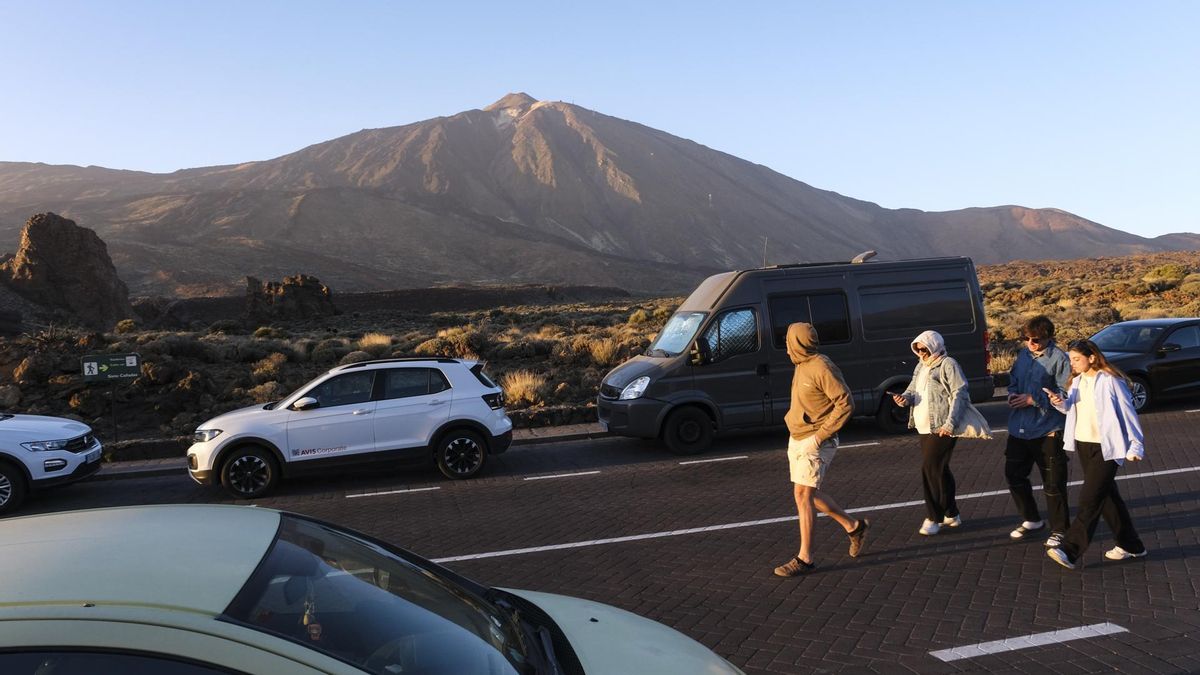The demographic burden on Teide, which recently celebrated its 70th anniversary as a national park on January 22, is concentrated in specific limited areas, but there is hope for 80% of its territory, thanks to its inaccessible geological structure.
Spanish scientist Wilfredo Wildpret explains to EFE that, despite this “fortunate” circumstance, the urban impact on the area is “severe,” particularly noticeable in three specific locations: the Cable Car activity area, access to the Pilón de Azúcar, and the road traversing the national park.
Teide has been acknowledged as the most visited national park in Spain and was listed as the 10th most visited national park in the world by ‘Viajes’ magazine, ranking 7th after the Serengeti (Tanzania).
Wildpret highlights that aside from attracting nearly 4 million visitors annually, the highest peak in Spain also accommodates around 500,000 cars every year, which leave behind an ecological footprint in the form of emissions and waste.
The origin of the intense traffic stems from its transformation into a prime tourist destination, contrasting the park’s vision before its designation when the “threats” pertained to grazing and the charcoal industry, resulting in limited vegetation cover.
While the presence of mouflons and the introduction of domestic bees still pose unresolved threats, current environmental concerns revolve around regulating tourist activities in the park: Are there plans for a tourist tax? What about penalties for tourists engaged in illegal activities?
Jaime Coello from the Telesforo Bravo Foundation, and environmental lawyer Guzmán Abreu, find the imposition of a tourist tax justifiable as it would not only facilitate enhanced conservation and services but also promote awareness-raising initiatives.
However, opinions differ regarding penalizing tourists, especially European or international visitors, with some supporting it and others highlighting the inherent challenges in enforcing such sanctions effectively.

Environmental Advocates to Demand Removal of World Heritage Designation
Amidst debates on public use of the national park, Teide commemorates its 70th anniversary, emphasizing the vital need to safeguard its landscape, unique geology, and diverse flora and fauna.
However, this “uniqueness” may be at risk, as environmentalist Jaime Coello believes that the Teide National Park “is suffering from its own success,” with “natural heritage being subordinated to economic interests.”
Coello asserts that environmental groups on the island will lodge complaints against the current regional and island management at international and national forums, and seek the removal of its World Heritage Site status, granted in 2007.
Environmental organizations are compiling a dossier outlining a range of illegal activities witnessed in the park, including filming, drone usage, and other unauthorized actions.Title: Exploring the Impact of Human Activity on Teide’s Natural Heritage
Desfortunatae Insulae, an environmental education platform, highlights on its Instagram profile the adverse effects of “unlawful activities” on the natural environment. These activities lead to degradation of the soil, geological formations, flora, fauna, forest fires, noise, and light pollution.
Such activities pose a threat to exclusive high mountain species like the Teide broom. The platform emphasizes the urgent need for citizen awareness to protect these species, which are already endangered due to the introduction of rabbits and the impact of climate change.
According to the platform, parking outside limited spaces and wandering off the trails cause harm to the adult specimens and emerging small plants of the Teide broom.
Challenges in Managing Transferred State Powers
Environmentalist Jaime Coello points out the decline in conservation efforts after the Spanish Government transferred the management of national parks to the autonomies. This transfer was effective in January 2010, significantly impacting conservation efforts.
Lawyer Guzmán Abreu highlights the characteristic evolution of transferred powers to the Autonomous Community, not only in the management of national parks but also in other areas like Coasts. The lack of necessary structures for these responsibilities exacerbates the challenges.
Guzmán Abreu emphasizes the struggles arising from the regional push to assume more state powers due to the lack of economic and organizational support within the autonomy itself. This lack of attention and resources has been particularly evident on islands like El Hierro.

Inadequate Environmental Surveillance and Security
The insufficient presence of environmental agents poses a significant challenge in ensuring the security and surveillance of Teide. After 4 PM, Teide remains unprotected, leaving areas like the Mirador de las Narices del Teide vulnerable to unauthorized activities.
José García Casanova, resigning from the Teide Board of Trustees, cited personal reasons and dissatisfaction with the park’s situation. This reflects the deep concerns among environmentalists and organizations regarding conservation efforts.
Challenges in Planning Natural Spaces
Environmentalists advocate for the renewal of the Master Plan for the Use and Management of Teide (PRUG), which has not been updated for at least two decades. The lack of renewal also extends to management plans in other protected spaces, creating applicability and drafting issues.
Highlighting the negligence in planning natural spaces, the specialist lawyer emphasizes the need for more attention and investment in these areas, especially in a region where 40% of the territory is protected.
















